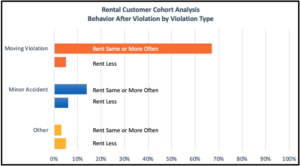In the high-stakes world of litigation, attorneys are constantly tasked with the meticulous dissection of opposing arguments. Instead of accepting the opposition’s stance wholesale, cohort analysis offers an innovative approach to break down the legal argument, uncover weak spots, and craft a clear, data-supported defense. By utilizing this analytical tool, legal professionals can either reduce damages or dismiss the case entirely. Let’s explore how cohort analysis can be applied to the legal context, from acquiring and managing data to deriving valuable insights.
What is Cohort Analysis?
Cohort Analysis is a form of behavioral analytics that takes data from a given set, such as medical patients, pharmacies, people who have rented cars, and groups it into related groups rather than looking at the data as one unit. The groupings are referred to as cohorts. They share similar characteristics such as time and size.
When Should Cohort Analysis be Used?
Cohort analysis is useful for legal cases where many people are impacted. This analysis allows us to group the many impacted people into cohorts and analyze the impacts for each separate group. The hope is to identify differences in the impacts across groups that will lead us to an argument against an assumption of uniform impact.
Steps
Step 1: Identifying and Acquiring Relevant Data
Effective cohort analysis begins with understanding the problem at hand and identifying the datasets that will provide meaningful insights. Cohort analysis requires a large enough sample size to build meaningful cohort groups. This means finding a data set with many records such as:
- Corporate Database Records: Useful for identifying people, services rendered, timelines, and evidence of performance. Typically contains fields that can be used to group into cohorts.
- Industry Standards and Historical Data: Offering a benchmark to compare against plaintiff’s claims.
Step 2: Uploading and Preparing Data
Once the data is gathered, it should be uploaded to a powerful analytical tool capable of managing large datasets and applying statistical analysis. The chosen software should be flexible enough to handle various data formats, including spreadsheets, database files, and text documents. This process ensures that the data is ready for analytical scrutiny, and patterns can be identified.
Step 3: Analyzing Data Using Cohort Analysis
With the data organized, the cohort analysis can begin. Here’s how it works:
- Define Cohorts: Create distinct groups based on relevant variables such as transaction dates, communication timelines, or contractual milestones. For instance, grouping customers based on the timing of their purchase helps identify how different cohorts behave over time.
- Track Metrics Over Time: Once cohorts are defined, analyze how each group behaves across different time intervals. For instance, if damages are claimed to have escalated after a particular event, look for trends within those timeframes to verify or refute that assertion.
- Compare Patterns Across Cohorts: Find discrepancies or patterns that challenge the opposing argument. For example, if the opposing side claims systemic issues, analyze communication and transactional data to identify exceptions that indicate otherwise.
By identifying patterns or exceptions within cohorts, attorneys can build an argument that methodically dismantles sweeping claims from the opposing side.
Step 4: Constructing a Data-Supported Argument
After completing the analysis, attorneys should summarize findings in a concise, compelling manner. This involves:
- Visualizing Insights: Use graphical representations like timelines, graphs, and heat maps to communicate trends and exceptions clearly.
- Drafting Narrative Reports: Craft narrative summaries that contextualize the data within the broader legal framework, making sure to emphasize how the findings support your case.
- Anticipating Counterarguments: Be prepared for opposing interpretations and build rebuttals using additional data.
Example
In a class action suit involving a rental car company, the company’s policy of automatically passing traffic citation charges to renters was challenged. A critical question from the defense: if the class members found the violation payment so objectionable, did they continue to rent from the company? For this case, multiple cohort behavior models were constructed (see one below). The analysis below suggests that the perceived impact depends on the cohort.

Conclusion
Cohort analysis offers a strategic edge for attorneys seeking to unravel opposing arguments. By meticulously identifying and analyzing data within meaningful groups, you can challenge generalized claims, highlight inconsistencies, and present a clear, data-supported argument. This approach can significantly influence litigation outcomes, leading to a reduction in damages or even dismissal of the case altogether. In the ever-evolving legal landscape, harnessing analytical tools will continue to empower attorneys in their quest for justice.
